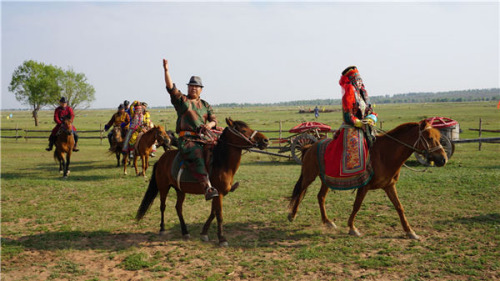
The 'bride' leaves after the mock wedding organized for diplomats and guests in the middle of a desert in Ordos, Inner Mongolia, June 27, 2015. (Photo/chinadaily.com.cn)
If a marriage ceremony offers a snapshot of culture then a Mongolian wedding showcases it in Technicolor.
I was provided a peek into the ritual at an event staged for guests during a tour organized by the Ministry of Culture to Inner Mongolia Autonomous Region.
The first thing that caught my eye at the mock ceremony was the 'bride'.
She wore a red silk dress on which intricate embroidery in green and orange ran from her shoulders to her ankles. As she entered the yurt she bowed, revealing a head-dress with coral and turquoise beads sewn around it.
Two bridesmaids wearing bright yellow dresses with strands of beads partially covering their ears and cheeks placed their hands on her arms and guided her to a silk cushion on a red and white carpet.
With her eyes still lowered, she sat between them.
A couple, faux parents of the bride, sitting on cushions nearby looked at her and then the 20-odd others present. The wide smiles and nodding of heads signified all of them were happy with the occasion.
There are some places in the world that offer so much that it becomes nearly impossible to pick and choose. Inner Mongolia is one.
From grasslands where horses and camels roam free under the blue sky to the Genghis Khan mausoleum to the economic and hi-tech centers, it has everything.
Although the marriage ceremony wasn't real, watching the 'groom' in elaborate robe, hat and riding boots arrive on a horse with friends on each side in the middle of a desert in Ordos city and then leave with his bride galloping on her horse is a sight worth experiencing.
Unlike so many other places, Inner Mongolia has somehow managed to retain its traditions and simultaneously transform itself into a modern region with world-class infrastructure and industries.
On the one hand, there is Yili, the eighth-largest dairy company in the world, in Hohhot, capital of the region and home to three million people.
















































